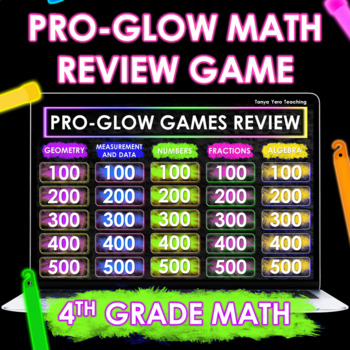GLOW DAY 4th Grade Math Game | Interactive Test Prep | Spiral Review
Tanya Yero Teaching
27.4k Followers
Grade Levels
4th - 5th, Homeschool
Subjects
Standards
CCSS4.MD.A.1
CCSS4.MD.A.2
CCSS4.MD.A.3
CCSS4.MD.B.4
CCSS4.MD.C.5
Formats Included
- Zip
- Google Apps™
- Internet Activities
Tanya Yero Teaching
27.4k Followers

Includes Google Apps™
The Teacher-Author indicated this resource includes assets from Google Workspace (e.g. docs, slides, etc.).
What educators are saying
This is a wonderful resource to use as a review before testing. Jeopardy is always an engaging game in my room, cause who doesn't love a little friendly competition?!
This was so much fun to use for an open house GLOW night. We had parents solving the problems with kids to see if they could figure out the answers too!
Description
This ready to go math game can be played with PowerPoint or Google Slides and an active board! Your students will enjoy answering questions and earning points while reviewing math standards!
CHECK OUT THE VIDEO PREVIEW TO SEE THIS ACTIVITY IN ACTION!
What's included in this resource?
- 3 versions: PowerPoint with Macros (interactive components), PowerPoint with NO Macros, and Google Slides
- 25 ready to go 4th grade math questions
- Questions that build in complexity based on point values
- Answers with explanations so you can review math curriculum with your students
- Interactive buttons for easy navigation within game
- Directions for easy implementation
- Answer keys
- Covers all 4th grade math standards
- Everything you need is here!
Benefits of this resource:
- Whether you are in a traditional classroom setting, completing distancing learning, or a mix of both you’ll have key resources to review math skills
- NO PREP
- Academically engaging
- Review math skills in a fun and interactive way
- Test prep that is more than a worksheet!
Who should purchase this resource?
- Teachers looking for resources that can be used in the classroom and for distance learning
- Teachers needing resources that are FUN yet RIGOROUS
- Teachers looking for digital activities for math review, math test prep, or math practice
- Teachers wanting READY TO GO digital activities
Total Pages
Answer Key
Included
Teaching Duration
N/A
Report this resource to TPT
Reported resources will be reviewed by our team. Report this resource to let us know if this resource violates TPT’s content guidelines.
Standards
to see state-specific standards (only available in the US).
CCSS4.MD.A.1
Know relative sizes of measurement units within one system of units including km, m, cm; kg, g; lb, oz.; l, ml; hr, min, sec. Within a single system of measurement, express measurements in a larger unit in terms of a smaller unit. Record measurement equivalents in a two-column table. For example, know that 1 ft is 12 times as long as 1 in. Express the length of a 4 ft snake as 48 in. Generate a conversion table for feet and inches listing the number pairs (1, 12), (2, 24), (3, 36),...
CCSS4.MD.A.2
Use the four operations to solve word problems involving distances, intervals of time, liquid volumes, masses of objects, and money, including problems involving simple fractions or decimals, and problems that require expressing measurements given in a larger unit in terms of a smaller unit. Represent measurement quantities using diagrams such as number line diagrams that feature a measurement scale.
CCSS4.MD.A.3
Apply the area and perimeter formulas for rectangles in real world and mathematical problems. For example, find the width of a rectangular room given the area of the flooring and the length, by viewing the area formula as a multiplication equation with an unknown factor.
CCSS4.MD.B.4
Make a line plot to display a data set of measurements in fractions of a unit (1/2, 1/4, 1/8). Solve problems involving addition and subtraction of fractions by using information presented in line plots. For example, from a line plot find and interpret the difference in length between the longest and shortest specimens in an insect collection.
CCSS4.MD.C.5
Recognize angles as geometric shapes that are formed wherever two rays share a common endpoint, and understand concepts of angle measurement:





